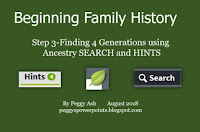Beginning Family History Step 6-The FamilySearch Updated Person Page

Beginning Family History Step 6-The FamilySearch Person Page Peggy Ash Now that we have a tree and record hints attached we need to take a closer look at what FamilySearch calls the "Person Page". When a new individual is added to the FamilySearch Family Tree they are assigned an identification number and a Person Page is created for them. The Person Page has only as much or as little information as users have entered. Most Person Page's could benefit from a little TLC. TLC comes in the form of verifying, standardizing, correcting, adding, and organizing information. A Person Page can become a work of art when well crafted. Make your 4 generations a valuable masterpiece! This PowerPoint will give you some tips and hints: Beginning Family History Step 6-The FamilySearch Updated Person Page PowerPoint PDF


